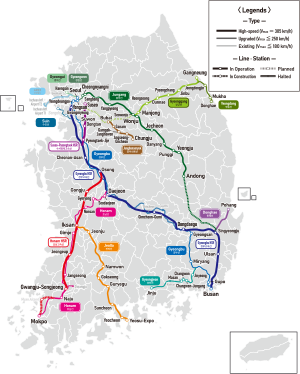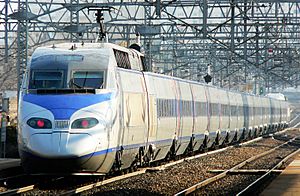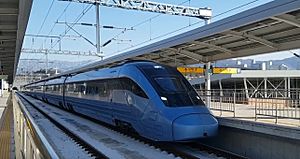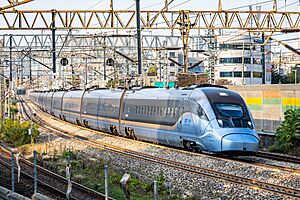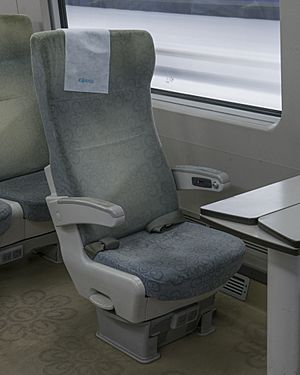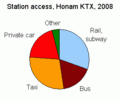KTX facts for kids
Quick facts for kids KTX |
|||||
|---|---|---|---|---|---|
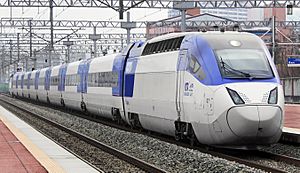
KTX-Sancheon
|
|||||
| Overview | |||||
| Service type |
|
||||
| Status | Operating | ||||
| Locale | South Korea | ||||
| First service | 1 April 2004 | ||||
| Current operator(s) | Korail | ||||
| On-board services | |||||
| Class(es) |
|
||||
| Disabled access | Fully accessible | ||||
| Catering facilities | Yes | ||||
| Entertainment facilities | Yes | ||||
| Baggage facilities | Yes | ||||
| Technical | |||||
| Rolling stock |
|
||||
| Track gauge | 1,435 mm (4 ft 8 1⁄2 in) Standard gauge | ||||
| Electrification | 25 kV/60 Hz overhead catenary | ||||
| Operating speed | Up to 305 km/h (190 mph) | ||||
|
|||||
KTX, which stands for Korea Train eXpress, is South Korea's first system of high-speed trains. Run by a company called Korail, these super-fast trains connect cities all across the country. The first KTX service started on April 1, 2004, after many years of planning and building.
Most KTX trains start their journey from Seoul Station and travel to many different destinations. They can reach a top speed of 305 km/h (190 mph), which is about as fast as a race car! The tracks were built to handle even faster speeds, up to 350 km/h (220 mph).
The very first KTX trains were based on the famous French TGV trains. Since then, South Korea has developed its own high-speed trains, like the KTX-Sancheon and the newer KTX-Eum and KTX-Cheongryong. These new trains have made South Korea one of only a few countries in the world that can build trains that travel over 420 km/h (260 mph).
Contents
Why Was KTX Built?
By the 1970s, the main road and railway between South Korea's two biggest cities, Seoul and Busan, were getting very crowded. This route, called the Seoul-Busan corridor, was home to most of the country's people and handled a lot of passenger and freight traffic. The government knew that a new, faster way to travel was needed.
Studies showed that a high-speed railway would be the best solution. It would allow people to travel between Seoul and Busan in under two hours. In 1989, the government gave the green light to start the project. The Korea High Speed Rail Construction Authority (KHSRCA) was created in 1992 to manage the building of the new line.
Building the First High-Speed Line
Construction on the first high-speed railway, the Gyeongbu high-speed railway, began on June 30, 1992. The project was so big that it was split into two main parts, or phases.
Phase 1: Seoul to Daegu
The first phase of the project focused on building a new high-speed line from the outskirts of Seoul to the city of Daegu. This part of the line opened on April 1, 2004. For the rest of the trip to Busan, the KTX trains used the existing, slower tracks, which had been upgraded.
The technology for the trains and tracks came from Alstom, the French company that builds the TGV. As part of the deal, Korean companies worked with Alstom to learn how to build high-speed rail technology themselves.
Phase 2: Daegu to Busan
The second phase involved building the final high-speed section of the track from Daegu to Busan. This part of the line was more difficult to build because it had many tunnels and bridges. One of the tunnels, the Geomjeung Tunnel, is over 20,000 m (66,000 ft) long, making it one of the longest in Korea.
After some delays, this final section opened on November 1, 2010. With the full high-speed line complete, the travel time between Seoul and Busan was cut down to just over two hours.
The Different KTX Trains
There are several types of KTX trains, each with its own special features.
KTX-I
The KTX-I was the original KTX train. A total of 46 of these trains were built. The first 12 were made in France, and the rest were built in South Korea by Rotem. Each train has 20 cars and can carry up to 935 passengers. It was designed to travel at 300 km/h (186 mph).
KTX-Sancheon
The KTX-Sancheon was the first high-speed train designed and built in South Korea. It is named after the cherry salmon, a fish found in Korea. These trains are shorter than the KTX-I, with 10 cars, and can carry 363 passengers. They have more comfortable seats and other improvements.
Soon after they started running in 2010, the KTX-Sancheon trains had some technical problems. However, these issues were fixed, and new and improved versions of the train have been built for newer high-speed lines.
KTX-Eum
The KTX-Eum is a newer type of high-speed train that started running in 2021. It is an electric multiple unit (EMU), which means that instead of having engines at the front and back, the motors are spread out under the passenger cars. This helps the train speed up and slow down more quickly. The KTX-Eum runs on lines with a top speed of 260 km/h (160 mph).
KTX-Cheongryong
The KTX-Cheongryong is the newest and fastest train in the KTX family, entering service in 2024. It is a sister train to the KTX-Eum but is designed to travel on the main high-speed lines at up to 320 km/h (200 mph). Its name means "Blue Dragon," representing the Year of the Blue Dragon in 2024 when it launched.
Riding the KTX
KTX trains offer two types of seating: First Class and Standard Class. First Class seats are wider and have more legroom. In Standard Class, some seats face forward while others face backward. On the newer trains, all seats can be turned to face the direction of travel.
Tickets can be bought at stations, online, or through a mobile app. Prices depend on the distance, the day of the week, and the type of seat. There are discounts for children, families, and frequent travelers.
When KTX first launched, it completely changed how people travel in South Korea. It became much faster to travel long distances by train than by car or bus. The number of people flying on airplanes between Seoul and Busan also dropped a lot because the KTX was so convenient.
KTX Routes
KTX trains run on several major routes, connecting Seoul to cities all over the country.
- Gyeongbu Line: This is the main line from Seoul to Busan.
- Honam Line: This line connects Seoul to southwestern cities like Gwangju and Mokpo.
- Gyeongjeon Line: This route goes from Seoul to southern cities like Masan and Jinju.
- Jeolla Line: This line connects Seoul to cities like Jeonju and Yeosu.
- Gangneung Line: This route travels east from Seoul to Gangneung on the coast.
Images for kids
See also
 In Spanish: Korea Train Express para niños
In Spanish: Korea Train Express para niños
- Super Rapid Train (SRT)
- High-speed rail in South Korea
- ITX-Saemaeul
- ITX-Maum
- Mugunghwa-ho
- Nuriro
- Rail transport in South Korea
- Transport in South Korea
- Train to Busan, a horror film in which the KTX and its train feature heavily in the plot


